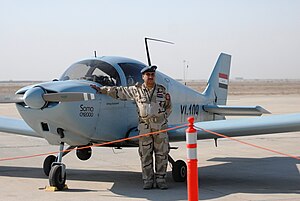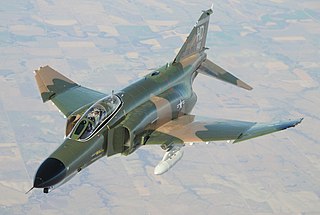
The McDonnell Douglas F-4 Phantom II is an American tandem two-seat, twin-engine, all-weather, long-range supersonic jet interceptor and fighter-bomber originally developed by McDonnell Aircraft for the United States Navy. Proving highly adaptable, it first entered service with the Navy in 1961 before it was adopted by the United States Marine Corps and the United States Air Force, and by the mid-1960s it had become a major part of their air arms. Phantom production ran from 1958 to 1981 with a total of 5,195 aircraft built, making it the most produced American supersonic military aircraft in history, and cementing its position as an iconic combat aircraft of the Cold War.

The Mikoyan-Gurevich MiG-21 is a supersonic jet fighter and interceptor aircraft, designed by the Mikoyan-Gurevich Design Bureau in the Soviet Union. Its nicknames include: "balalaika", because its planform resembles the stringed musical instrument of the same name; "Ołówek", Polish for "pencil", due to the shape of its fuselage, and "Én Bạc", meaning "silver swallow", in Vietnamese.

The Mikoyan-Gurevich MiG-23 is a variable-geometry fighter aircraft, designed by the Mikoyan-Gurevich design bureau in the Soviet Union. It is a third-generation jet fighter, alongside similar Soviet aircraft such as the Su-17 "Fitter". It was the first Soviet fighter to field a look-down/shoot-down radar, the RP-23 Sapfir, and one of the first to be armed with beyond-visual-range missiles. Production started in 1969 and reached large numbers with over 5,000 aircraft built, making it the most produced variable-sweep wing aircraft in history. Today the MiG-23 remains in limited service with some export customers.

The Mikoyan-Gurevich MiG-25 is a supersonic interceptor and reconnaissance aircraft that is among the fastest military aircraft to enter service. Designed by the Soviet Union's Mikoyan-Gurevich bureau, it is one of the few combat aircraft built primarily using stainless steel. It was to be the last plane designed by Mikhail Gurevich, before his retirement.
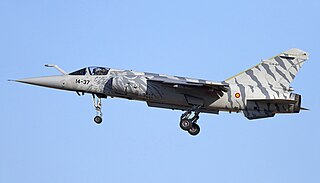
The Dassault Mirage F1 is a French fighter and attack aircraft designed and manufactured by Dassault Aviation. It was developed as a successor to the popular Mirage III family.
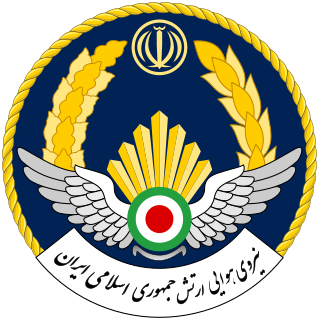
The Islamic Republic of Iran Air Force is the aviation branch of the Islamic Republic of Iran Army. The present Air Force came into being when the Imperial Iranian Air Force was renamed in 1979. It is one of the few air forces in the Middle East with experience in a conventional war, having fought the Iran–Iraq War. It has carried out major operations like Operation Kaman 99, Operation Sultan 10, the H-3 airstrike, and the first attack on a nuclear reactor in history, Operation Scorch Sword. As a result of fighting a brutal and intense non-stop air war for 8 years, the IRIAF has the highest number of fighter aces in the region, having as many as 7 people with more than 6 kills. Most of these aces achieved their status flying the F-14 Tomcat jet. Evolving from its experiences in that conflict, the IRIAF has developed real battle tested tactics and a cadre of skillful pilots. Many of them, both veterans of the 8-year war and senior generals, form the core of today's IRIAF command.

The Tupolev Tu-22 was the first supersonic bomber to enter production in the Soviet Union. Manufactured by Tupolev, the Tu-22 entered service with the Soviet military in the 1960s.
The MolniyaR-60 is a short-range lightweight infrared homing air-to-air missile designed for use by Soviet fighter aircraft. It has been widely exported, and remains in service with the CIS and many other nations.

The Iraqi Air Force is the aerial warfare service branch of the Iraqi Armed Forces. It is responsible for the defense of Iraqi airspace as well as the policing of its international borders. The IQAF also acts as a support force for the Iraqi Navy and the Iraqi Army, which allows Iraq to rapidly deploy its military. It is headquartered in Baghdad; the current commander is Gen. Shihab Jahid Ali.

The Romanian Air Force (RoAF) is the air force branch of the Romanian Armed Forces. It has an air force headquarters, an operational command, five airbases and an air defense brigade. Reserve forces include one air base and three airfields.
The Grumman F-14 Tomcat has served with the United States Navy and the Islamic Republic of Iran Air Force (IRIAF) It operated aboard U.S. aircraft carriers from 1974 to 2006 and remains in service with Iran. In-depth knowledge of its service with Iran is relatively limited.
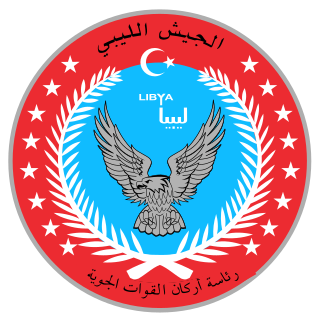
The Libyan Air Force is the branch of the Libyan Armed Forces responsible for aerial warfare. In 2010, before the Libyan Civil War, the Libyan Air Force personnel strength was estimated at 18,000, with an inventory of 374 combat-capable aircraft operating from 13 military airbases in Libya. Since the 2011 civil war and the ongoing conflict, multiple factions fighting in Libya are in possession of military aircraft. As of 2019 the Libyan Air Force is nominally under the control of the internationally recognised Government of National Accord in Tripoli, though the rival Libyan National Army of Marshal Khalifa Haftar also has a significant air force. In 2021, the air force is under command of the new President of Libya, Mohamed al-Menfi that replaced Fayez al-Sarraj.

The 23rd Squadron of the Iraqi Air Force is an air transport squadron operating the Lockheed C-130 Hercules.

The Seabird Seeker is a light observation aircraft built originally by Seeker Aviation Australia and Seabird Aviation Jordan. Since 2016 it has been manufactured in the US by Seeker Aircraft (US)/Erickson. It is powered by a Lycoming O-360 engine. The aircraft is marketed as a low cost alternative to observation helicopters for the military and civilian sectors. It can be used in roles such as pipeline inspection, coast watch, environmental duties, aerial photography and security. The Seabird Seeker has had some export success, and is operated by the Iraqi Air Force.

The 123d Fighter Squadron is a unit of the Oregon Air National Guard 142d Fighter Wing located at Portland Air National Guard Base, Oregon. The 123d is equipped with the McDonnell Douglas F-15C Eagle.
The 3rd Squadron, Iraqi Air Force is one of two reconnaissance squadrons of the Iraqi Air Force, the other being the 70th Squadron based in Basra.
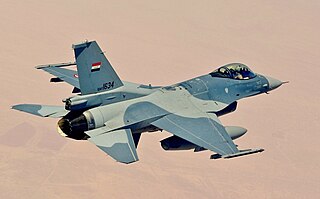
The 9th (Fighter) Squadron is a squadron of the Iraqi Air Force.

The 120th Separate Guards Fighter Aviation Regiment is a fighter aviation regiment of the Russian Air Force. Based at Domna, the regiment is part of the 11th Air and Air Defense Forces Army and flies the Sukhoi Su-30SM.
